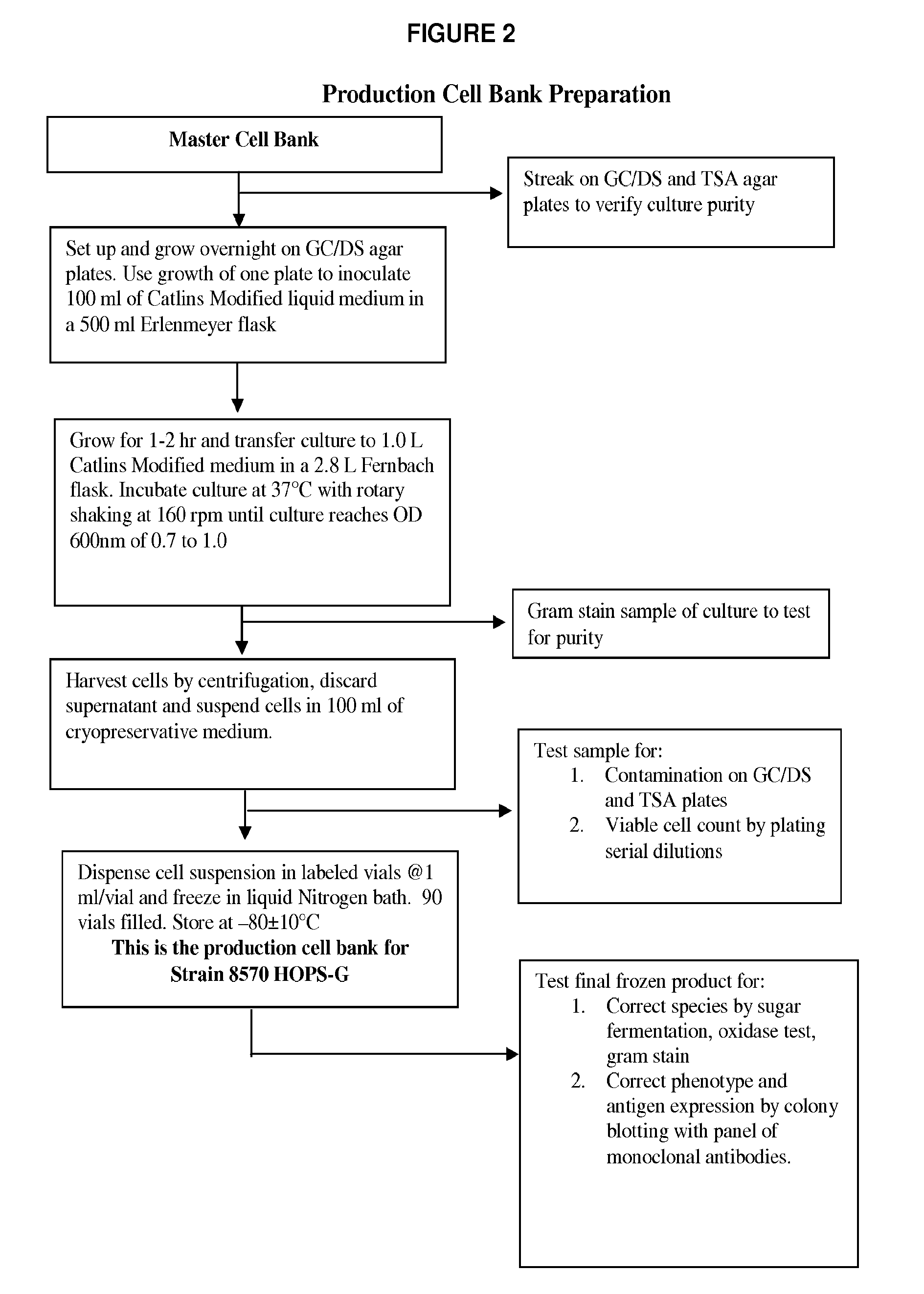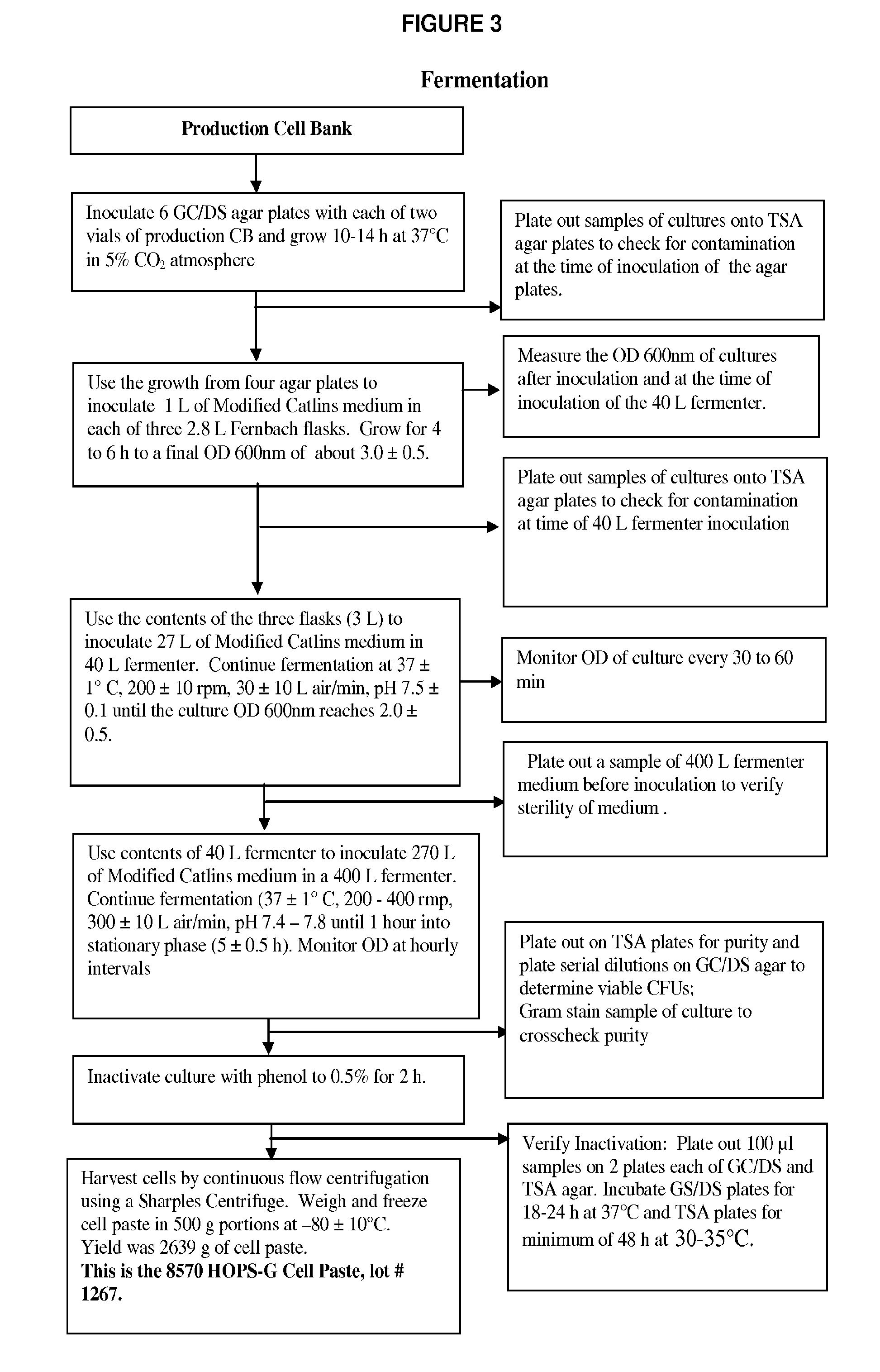Meningococcal multivalent native outer membrane vesicle vaccine, methods of making and use thereof
a technology of native outer membrane and meningitis, which is applied in the field of making and using meningitis multivalent native outer membrane vesicle vaccine, can solve the problems of ineffective capsular polysaccharide which defines the serogroup, increased risk of use, and increased difficulty in developing suitable vaccines for children's neisseria meningitidis group b strains, etc., to achieve the effect of increasing or stabilizing at least one minor and stabil
- Summary
- Abstract
- Description
- Claims
- Application Information
AI Technical Summary
Benefits of technology
Problems solved by technology
Method used
Image
Examples
example 1
Derivation of the Genetically Modified Vaccine Strain of N. Meningitidis and Production of NOMVs Containing the Outer Membrane Proteins of the Genetically Modified Vaccine Strain
[0070]The genetically modified strain 8570 HOPS-G1 was modified by five genetic modifications from a parental strain 8570 which had been analyzed by multilocus enzyme electrophoresis by the laboratory from whom the strain was obtained and determined to belong to the ET-5 clonal complex (Caugant, et al.) The PorA variable regions were sequenced typed and the LOS immunotype was verified before the genetic modifications were made. Strain 8570 was and ET-5 clone 4:P1.19, 15:L7v, ProB3 (ST4) Tbp2 type II. A series of five sequential genetic modifications were made to the strain as described below:
[0071]1) A second, different porA gene was inserted at the opaD locus knocking out the opaD gene. pUC19-based plasmid pA 18.4 has no antibiotic resistance marker in the insert, was used to insert a second porA gene into ...
example 2
Production of Vaccine Amounts of the Genetically Modified Strain
[0078]The genetically modified strains were then used for production of master and production cell banks for use in vaccine manufacture as detailed in the flow-charts in FIGS. 1-5 to produce a composition of NOMVs. The NOMVs culture is tested for the expression of the outer membrane proteins and LOS.
example 3
Characterization of Vaccines
[0079]The final product obtained from Example 2 was subjected to quality control testing and preclinical safety and immunogenicity testing in mice and rabbits.
[0080]The composition of the final product vaccine was:[0081]Protein 2001 ag / ml[0082]Lipooligosaccharide 36 tg / ml[0083]Nucleic Acid 2.5 μg / ml[0084]Sodium Chloride 0.9%[0085]Tris-HCl Buffer 0.01 M pH 7.6
[0086]The vaccine composition was further analyzed by sodium dodecyl sulfate polyacrylamide gel electrophoresis and western blotting. FIG. 6 depicts coomassie blue stained gel showing protein content in the vaccine (lane 4) as compared to control (lane 2) and filtered bulk lot (lane 3). FIG. 7 depicts silver stain gel showing the liposaccharide component of the vaccine (lane 3) as compared with control (ML5 LPS, land 1) and filtered bulk vaccine lot (lane 2). FIG. 8 depicts the results of identity testing of the vaccine for the major components of the NOMVs vaccine according to the antibodies as liste...
PUM
| Property | Measurement | Unit |
|---|---|---|
| temperature | aaaaa | aaaaa |
| core structure | aaaaa | aaaaa |
| drug resistance | aaaaa | aaaaa |
Abstract
Description
Claims
Application Information
 Login to View More
Login to View More - R&D
- Intellectual Property
- Life Sciences
- Materials
- Tech Scout
- Unparalleled Data Quality
- Higher Quality Content
- 60% Fewer Hallucinations
Browse by: Latest US Patents, China's latest patents, Technical Efficacy Thesaurus, Application Domain, Technology Topic, Popular Technical Reports.
© 2025 PatSnap. All rights reserved.Legal|Privacy policy|Modern Slavery Act Transparency Statement|Sitemap|About US| Contact US: help@patsnap.com



